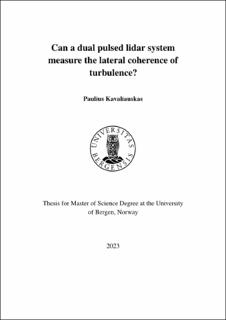Can a dual pulsed lidar system measure the lateral coherence of turbulence?
Master thesis
Permanent lenke
https://hdl.handle.net/11250/3083245Utgivelsesdato
2023-08-10Metadata
Vis full innførselSamlinger
- Master theses [123]
Sammendrag
Characterizing the coherence of turbulence in the marine boundary layer faces a significant challenge due to the limited availability of offshore measurements within the relevant altitude ranges, particularly up to 250 m. The coherence of turbulence describes the spatial correlation of wind velocity fluctuations, which is a key parameter for determining environmental loading on wind turbines. The turbulent wind loading represents one of the main uncertainties faced by the offshore wind engineering sector. Uncertainties arising from turbulent wind loading represent major challenges in the offshore wind engineering sector. Advancements in remote sensing technology, such as Doppler wind lidars, have opened new possibilities for studying wind turbulence at heights relevant to the increasing size of wind turbine rotors. This master’s thesis presents an analysis of 15 days of wind records collected by two pulsed wind lidars and two sonic anemometers during the COTUR project at Obrestad lighthouse, located on the southwestern coast of Norway. The site is expected to predominantly represent offshore conditions. The primary objective of this study is to assess the capability of pulsed Doppler wind lidar instruments in capturing the lateral co-coherence of turbulence along the wind component. Wind records obtained by the sonic anemometers mounted on 11 m high masts are used as reference data. The analysis focuses on both single and two-point statistics of wind turbulence, with particular emphasis on studying the co-coherence of turbulence. The results revealed that wind sectors aligned with northerly or southerly wind directions are suitable for comparison studies. In these wind directions, a good agreement is found between the two different instruments. Comparing co-coherence estimates obtained from pulse lidar and sonic anemometer showed negligible differences, indicating that spatial averaging did not significantly affect the estimation of co-coherence. By assessing the ability of pulsed Doppler wind lidar instruments to capture turbulence co-coherence, this study contributes to the applicability of lidar technology for characterizing turbulence and its potential for improving assessments of environmental loading on offshore wind turbines
Utgiver
The University of BergenOpphavsrett
Copyright the Author. All rights reservedBeslektede innførsler
Viser innførsler beslektet ved tittel, forfatter og emneord.
-
Promoting Coherent Science Instruction through Coherent Science Teacher Education: A Model Framework for Program Design
Nordine, Jeffrey; Sorge, Stefan; Delen, Ibrahim; Evans, Robert; juuti, kalle; Lavonen, Jari; Nilsson, Pernilla; Ropohl, Mathias; Stadler, Matthias Gregor (Journal article; Peer reviewed, 2021)Recent research and reform efforts in science education have consistently stressed the importance of coherent science instruction, in which learning opportunities are connected and contextualized by meaningful phenomena, ... -
On the Persistent Shape and Coherence of Pulsating Auroral Patches
Humberset, Beate Krøvel; Gjerløv, Jesper; Mann, Ian R.; Michell, Robert; Samara, Marilla (Peer reviewed; Journal article, 2018-05)The pulsating aurora covers a broad range of fluctuating shapes that are poorly characterized. The purpose of this paper is therefore to provide objective and quantitative measures of the extent to which pulsating auroral ... -
Photopic full-field electroretinography and optical coherence tomography in type 1 diabetic retinopathy
Jansson, Ragnhild Wivestad; Ræder, Maria B.; Krohn, Jørgen Gitlesen (Peer reviewed; Journal article, 2015-07)Purpose: The purpose of this study was to evaluate the role of photopic full-field electroretinography (ERG) and retinal thickness measurements by spectral-domain optical coherence tomography (SD-OCT) in the assessment of ...
